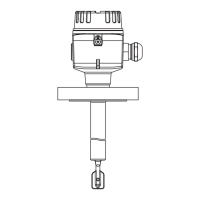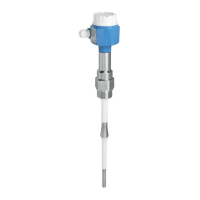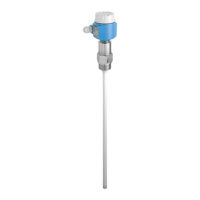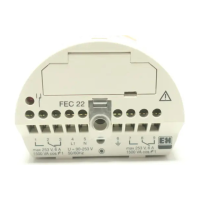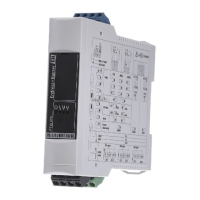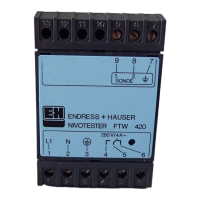Do you have a question about the Endress+Hauser Liquiphant FTL64 and is the answer not in the manual?
Outlines the manual's scope covering the device lifecycle from identification to disposal.
Explains safety, electrical, tool, communication, and graphic symbols used throughout the manual.
Details qualifications, authorization, and understanding required for personnel handling the device.
Defines correct device application and specifies potential hazards from incorrect usage.
Emphasizes the use of Personal Protective Equipment (PPE) and safe working environments.
Addresses safe operation, risks of unauthorized modifications, and repair guidelines.
Covers SIL applications, IT security, and device-specific security functions.
Introduces the Liquiphant FTL64's core function and suitability for high-temperature applications.
Details checks for order codes, damage, and nameplate data upon device receipt.
Describes how to identify the device using nameplates and digital tools like W@M Device Viewer.
Provides instructions for safe storage and transit of the device, including temperature limits.
Covers orientation, clearances, and prerequisites for installing the device.
Details temperature difference limits for PFA-coated devices and the need for insulation.
Explains how orientation affects switch points and the influence of viscosity on installation.
Offers advice on installation to minimize buildup and ensure proper function.
Highlights the need for adequate external space for mounting and connection tasks.
Stresses the importance of supporting the device to avoid damage from shocks and vibrations.
Lists required tools and outlines the steps for installing the device, including fork alignment.
Details installation in pipes, considering flow, fork position, and markings.
Explains how to screw in the device, specifying torque and avoiding housing rotation.
Covers aligning the cable entry, ensuring a drip loop, and rotating the housing.
Provides instructions for closing the housing cover, emphasizing thread cleanliness.
Explains how to rotate the display module and associated warnings.
Lists essential checks after mounting to ensure correct installation and function.
Lists necessary tools and crucial requirements for safe electrical connection.
Covers supply voltage, terminal specifications, and cable requirements for connection.
Details the HART connection, resistor needs, and overvoltage protection measures.
Offers step-by-step wiring guidance, including cable entry and housing closure safety.
Illustrates the terminal layout for single-compartment housings.
Shows terminal configurations for dual-compartment L-shaped housings.
Describes various cable entry types and the convenience of available device plugs.
Explains IP ratings for housing and M12 plugs, emphasizing correct installation.
Provides a checklist for verifying electrical connections and device integrity.
Outlines various methods for operating the device, including keys, display, and wireless.
Describes the operating keys and DIP switches on the HART electronic insert.
Details the steps for conducting a function test using the electronic insert's operating key.
Compares operating menus and explains user roles and access authorization.
Describes how to operate the device using the optional local display and its functions.
Explains how to operate the device wirelessly via Bluetooth using the SmartBlue app.
Describes how to access the device menu using HART communication and operating tools.
Lists device description files and measured variables for HART protocol.
Details device variables, system units, and crucial safety warnings for commissioning.
Highlights safety aspects related to current output settings during commissioning.
Describes default settings and the importance of function checks before commissioning.
Details how to establish communication with the device using FieldCare and DeviceCare via HART.
Details CDI connection, firmware updates, and configuring device addresses.
Explains how to set the operating language on the local display and using FieldCare/DeviceCare.
Details the process of commissioning using the electronic insert's DIP switches and operating keys.
Provides instructions for resetting the device password and the device itself using operating keys.
Explains the use of the commissioning wizard and storing oscillation frequencies.
Describes the simulation submenu for testing various parameters.
Explains how to lock and unlock hardware and display operations to prevent unauthorized access.
Details software methods for securing parameter configuration, including user roles and passwords.
Explains how to read the device's locking status and measured values.
Details configuring the device for level limit detection based on process conditions.
Details how to configure the device for sensor frequency operation in 4-20 mA mode.
Explains the Heartbeat Verification wizard and the Heartbeat submenu.
Describes the proof test wizard for SIL and WHG applications.
Provides guidance on general errors, including device not responding and display issues.
Addresses common errors and connection issues encountered with SmartBlue and Bluetooth operation.
Covers additional diagnostic tests and how the current output behaves during faults.
Explains how diagnostic messages are displayed on the local screen.
Explains status signals (F, C, S, M), diagnostic events, and event text for fault identification.
Covers how diagnostic events appear in tools, how to adapt information, and the diagnostic list.
Explains how to view queued diagnostic messages and filter the event log.
Describes the event logbook, its history, and the types of events recorded.
Explains how to use filters to display specific categories of event messages.
Lists and describes various information events recorded by the device.
Details methods for resetting the device using software, display, or operating keys.
Explains how to access comprehensive device information through the Information submenu.
Covers firmware version history and general maintenance procedures like cleaning.
Covers general repair concepts, special notes for Ex-certified devices, and spare part ordering.
Details component replacement, HistoROM handling, and the procedure for returning a device.
Provides environmental disposal guidelines and information on the Device Viewer accessory.
Describes the aluminum weather protection cover for dual-compartment housings.
Details protective covers for single compartment housings and specifications for M12 plug-in jacks.
Describes sliding sleeves for unpressurized and high-pressure operations, including material and order details.
Details the measured variables and the device's measuring range.
Covers the output signal types, including SIO and continuous 4-20 mA operation.
Details signal on alarm, load characteristics, damping, and switch output delay times.
Covers HART protocol data, device variables, and supported functions.
Provides technical data for Wireless HART communication.
Introduces the three modules of the Heartbeat Technology package.
Details the permitted ambient temperature ranges for the device under various conditions.
Covers storage temperature, humidity limits, and maximum operating height.
Details climate class, degree of protection (IP ratings), vibration, and shock resistance.
Specifies mechanical load capacity, pollution degree, and electromagnetic compatibility (EMC).
Details process temperature limits, thermal shock, and warnings regarding process pressure.
Covers test pressure specifications and the state of aggregation (liquid).
Details medium density settings and their relevance for device operation.
Specifies viscosity limits, pressure tightness, and solids content handling.
Outlines the manual's scope covering the device lifecycle from identification to disposal.
Explains safety, electrical, tool, communication, and graphic symbols used throughout the manual.
Details qualifications, authorization, and understanding required for personnel handling the device.
Defines correct device application and specifies potential hazards from incorrect usage.
Emphasizes the use of Personal Protective Equipment (PPE) and safe working environments.
Addresses safe operation, risks of unauthorized modifications, and repair guidelines.
Covers SIL applications, IT security, and device-specific security functions.
Introduces the Liquiphant FTL64's core function and suitability for high-temperature applications.
Details checks for order codes, damage, and nameplate data upon device receipt.
Describes how to identify the device using nameplates and digital tools like W@M Device Viewer.
Provides instructions for safe storage and transit of the device, including temperature limits.
Covers orientation, clearances, and prerequisites for installing the device.
Details temperature difference limits for PFA-coated devices and the need for insulation.
Explains how orientation affects switch points and the influence of viscosity on installation.
Offers advice on installation to minimize buildup and ensure proper function.
Highlights the need for adequate external space for mounting and connection tasks.
Stresses the importance of supporting the device to avoid damage from shocks and vibrations.
Lists required tools and outlines the steps for installing the device, including fork alignment.
Details installation in pipes, considering flow, fork position, and markings.
Explains how to screw in the device, specifying torque and avoiding housing rotation.
Covers aligning the cable entry, ensuring a drip loop, and rotating the housing.
Provides instructions for closing the housing cover, emphasizing thread cleanliness.
Explains how to rotate the display module and associated warnings.
Lists essential checks after mounting to ensure correct installation and function.
Lists necessary tools and crucial requirements for safe electrical connection.
Covers supply voltage, terminal specifications, and cable requirements for connection.
Details the HART connection, resistor needs, and overvoltage protection measures.
Offers step-by-step wiring guidance, including cable entry and housing closure safety.
Illustrates the terminal layout for single-compartment housings.
Shows terminal configurations for dual-compartment L-shaped housings.
Describes various cable entry types and the convenience of available device plugs.
Explains IP ratings for housing and M12 plugs, emphasizing correct installation.
Provides a checklist for verifying electrical connections and device integrity.
Outlines various methods for operating the device, including keys, display, and wireless.
Describes the operating keys and DIP switches on the HART electronic insert.
Details the steps for conducting a function test using the electronic insert's operating key.
Compares operating menus and explains user roles and access authorization.
Describes how to operate the device using the optional local display and its functions.
Explains how to operate the device wirelessly via Bluetooth using the SmartBlue app.
Describes how to access the device menu using HART communication and operating tools.
Lists device description files and measured variables for HART protocol.
Details device variables, system units, and crucial safety warnings for commissioning.
Highlights safety aspects related to current output settings during commissioning.
Describes default settings and the importance of function checks before commissioning.
Details how to establish communication with the device using FieldCare and DeviceCare via HART.
Details CDI connection, firmware updates, and configuring device addresses.
Explains how to set the operating language on the local display and using FieldCare/DeviceCare.
Details the process of commissioning using the electronic insert's DIP switches and operating keys.
Provides instructions for resetting the device password and the device itself using operating keys.
Explains the use of the commissioning wizard and storing oscillation frequencies.
Describes the simulation submenu for testing various parameters.
Explains how to lock and unlock hardware and display operations to prevent unauthorized access.
Details software methods for securing parameter configuration, including user roles and passwords.
Explains how to read the device's locking status and measured values.
Details configuring the device for level limit detection based on process conditions.
Details how to configure the device for sensor frequency operation in 4-20 mA mode.
Explains the Heartbeat Verification wizard and the Heartbeat submenu.
Describes the proof test wizard for SIL and WHG applications.
Provides guidance on general errors, including device not responding and display issues.
Addresses common errors and connection issues encountered with SmartBlue and Bluetooth operation.
Covers additional diagnostic tests and how the current output behaves during faults.
Explains how diagnostic messages are displayed on the local screen.
Explains status signals (F, C, S, M), diagnostic events, and event text for fault identification.
Covers how diagnostic events appear in tools, how to adapt information, and the diagnostic list.
Explains how to view queued diagnostic messages and filter the event log.
Describes the event logbook, its history, and the types of events recorded.
Explains how to use filters to display specific categories of event messages.
Lists and describes various information events recorded by the device.
Details methods for resetting the device using software, display, or operating keys.
Explains how to access comprehensive device information through the Information submenu.
Covers firmware version history and general maintenance procedures like cleaning.
Covers general repair concepts, special notes for Ex-certified devices, and spare part ordering.
Details component replacement, HistoROM handling, and the procedure for returning a device.
Provides environmental disposal guidelines and information on the Device Viewer accessory.
Describes the aluminum weather protection cover for dual-compartment housings.
Details protective covers for single compartment housings and specifications for M12 plug-in jacks.
Describes sliding sleeves for unpressurized and high-pressure operations, including material and order details.
Details the measured variables and the device's measuring range.
Covers the output signal types, including SIO and continuous 4-20 mA operation.
Details signal on alarm, load characteristics, damping, and switch output delay times.
Covers HART protocol data, device variables, and supported functions.
Provides technical data for Wireless HART communication.
Introduces the three modules of the Heartbeat Technology package.
Details the permitted ambient temperature ranges for the device under various conditions.
Covers storage temperature, humidity limits, and maximum operating height.
Details climate class, degree of protection (IP ratings), vibration, and shock resistance.
Specifies mechanical load capacity, pollution degree, and electromagnetic compatibility (EMC).
Details process temperature limits, thermal shock, and warnings regarding process pressure.
Covers test pressure specifications and the state of aggregation (liquid).
Details medium density settings and their relevance for device operation.
Specifies viscosity limits, pressure tightness, and solids content handling.
| Application | Liquids |
|---|---|
| Protection Rating | IP66/IP67 |
| Type | FTL64 |
| Device Type | Level Switch |
| Measuring Principle | Vibrating Fork |
| Output | Relay, NAMUR, PNP |
| Power Supply | 20 to 253 V AC / 20 to 60 V DC |
| Housing Material | Aluminum, stainless steel, plastic |
| Approvals | ATEX, IECEx |
| Process Connection | Threaded, flanged |
| Process Temperature | -50 to 150 °C (-58 to 302 °F) |
| Wetted Materials | 316L |
| Material | 316L |




